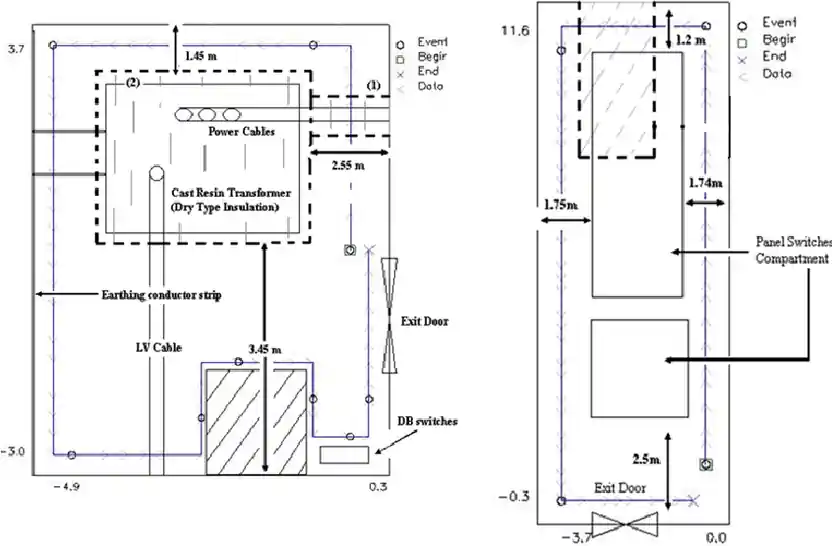In electrical infrastructure, two terms often arise when discussing power distribution—switch room و محطة فرعية. While these terms are sometimes used interchangeably, they serve distinct roles within the power supply network. Understanding the differences is essential for engineers, facility managers, and procurement specialists aiming to design safe, scalable, and efficient power systems.
Core Concept: Switch Room vs. Substation
A switch room is a designated area within a building or facility that houses low to medium voltage switchgear, which is used to control, protect, and isolate electrical circuits. It may include breakers, isolators, control panels, and busbars, but it does not usually include a power transformer.
A محطة فرعية, on the other hand, is a more comprehensive installation that includes دليل المحولات, المفاتيح الكهربائية, protection systemsو control equipment to step down or step up voltage levels between transmission and distribution systems.

مجالات التطبيق
Switch Room
- Commercial buildings (hotels, shopping centers)
- Industrial facilities (factories, processing plants)
- Data centers and hospitals
- Installed indoors, usually in the electrical floor or basement
محطة فرعية
- Utility power grids (transmission and distribution)
- Renewable energy integration (solar/wind farms)
- Airports, railways, and large-scale infrastructure projects
- Can be indoor, outdoorأو compact/prefabricated

Industry Trends and Market Evolution
With the rise of smart grids, modular substations, and renewable integration, the design and functionality of both substations and switch rooms have advanced significantly.
وفقاً ل IEEMA’s 2023 power infrastructure report, there’s a growing preference for intelligent switchgear in switch rooms equipped with IoT monitoring, arc flash detectionو SCADA integration.
Meanwhile, utilities are upgrading substations with GIS (Gas-Insulated Switchgear) و digital protection relays. Reports from معهد مهندسي الكهرباء والإلكترونيات IEEE و شنايدر إلكتريك also emphasize a convergence toward hybrid substations that combine traditional equipment with advanced sensors and communication protocols.
Technical Comparison
| الميزة | Switch Room | محطة فرعية |
|---|---|---|
| Voltage Range | Low to Medium Voltage (LV/MV) | Medium to High Voltage (MV/HV) |
| Includes Transformer? | No | Yes |
| Primary Function | Control & protection | Voltage transformation & switching |
| Typical Equipment | Breakers, busbars, isolators, control panels | Transformer, circuit breakers, relays, SCADA |
| Location | Indoor (within building) | Outdoor/Indoor/Prefabricated |
| Construction Complexity | معتدل | أعلى |
| الامتثال للمعايير | IEC 61439, IEC 60947 | IEC 62271, IEEE C37, IEC 60076 |
How to Choose: Switch Room or Substation?
The choice depends on several key factors:
- متطلبات الجهد
- If you’re handling 400V or 11kV loads inside a building, a switch room may suffice.
- For step-down from 33kV or higher, a substation is essential.
- Space and Site Constraints
- Switch rooms require less space and are integrated within structures.
- Substations need fenced yards or dedicated enclosures.
- سعة الطاقة
- Substations can handle loads exceeding 1 MVA, while switch rooms generally manage lower capacities.
- Regulatory and Utility Coordination
- Substations often require utility approval and are connected to grid feeders.
- Budget and Deployment Time
- Switch rooms are cheaper and faster to build.
- Substations involve civil work, protection design, and utility interfacing.
Leading providers like بينيل, ABB, Eatonو سيمنز offer both solutions with customizations aligned to IEC, ISو معهد مهندسي الكهرباء والإلكترونيات IEEE standards.
Authoritative Sources and References
- ويكيبيديا - المحطات الكهربائية الفرعية
- IEEE Std C37.100.1™: Application guide for switchgear
- IEC 62271: High-voltage switchgear and controlgear
- ABB Technical Paper: “Design Considerations for Indoor Switchgear Rooms”
- Schneider Electric Whitepaper: “Digital Substations in Urban Grids”
These references help validate design decisions and ensure long-term operational safety and compliance.
FAQs
A: No. A switch room lacks voltage transformation capability. Substations are essential where voltage stepping is needed (e.g., 33kV to 11kV or 11kV to 415V).
A: Yes. Many large projects feature a دليل المحطات الكهربائية الفرعية for transformation and a switch room for internal distribution and control.
A: Not necessarily. Both can be equally safe if properly designed. Switch rooms are typically indoors and easier to access, but substations often include more advanced protection schemes.
Understanding the difference between a switch room and a substation is vital for designing effective electrical distribution systems. While a switch room offers compact control within buildings, a substation is indispensable for حلول الجهد الكهربائي transformation and large-scale distribution.


